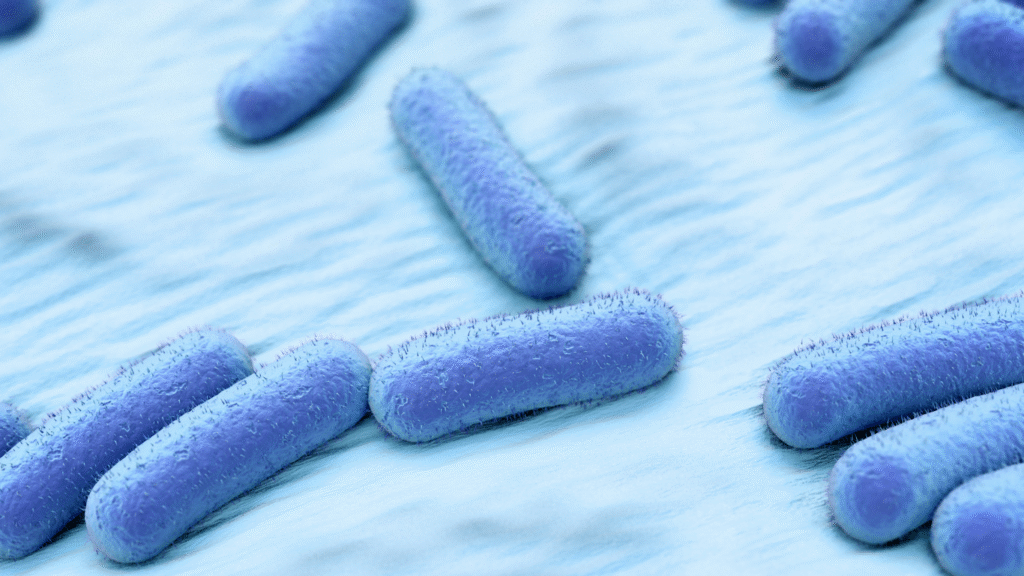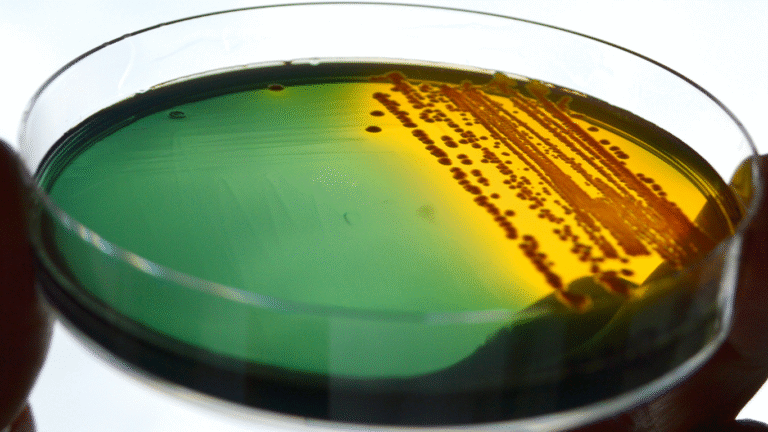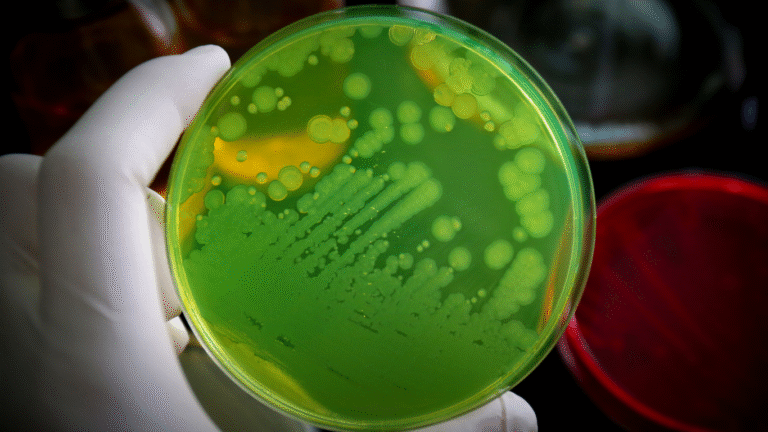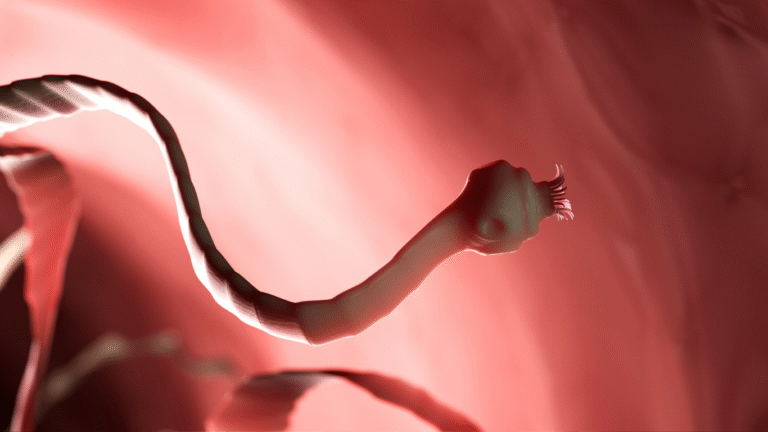Step inside the microscopic world of E. coli. Discover how this common bacteria lives in the human gut, what happens when it causes illness, and how to prevent infection.

The day begins in warmth. I drift in the soft, ever-moving current of the human intestine, a world alive with activity. All around me, food scraps float by like ships carrying nourishment, some half-digested, some breaking apart into smaller and smaller pieces. The walls of the gut rise up like moist canyon cliffs, lined with cells that absorb what the human needs. For me and my countless cousins, this place is paradise. The gut is dark, safe, and rich in nutrients. Here, I thrive quietly, contributing to the life of my host without being noticed. My role seems small, but it is essential. I help break down food and even produce vitamin K, which humans depend on for healthy blood clotting (NIH).
Life in the gut is bustling, but peaceful. There are billions of us living inside every human, an invisible community that usually coexists without harm. Together we form part of what people call the microbiome—a vast collection of microbes that influences digestion, immunity, and even mood. For the most part, Escherichia coli—better known as E. coli—are friendly neighbors. We stay balanced, working quietly while the host goes about their day, often completely unaware of our presence (CDC). But like any family, not every cousin is kind. Some carry dangerous instructions hidden deep in their DNA, instructions that can twist our ordinary lives into chaos.
Today, I sense one of those rowdy relatives drifting nearby, a strain humans call E. coli O157:H7. Unlike me, she doesn’t simply enjoy the leftover nutrients flowing through the gut. She has another plan. She clings tightly to the lining of the intestine, using specialized proteins that let her grip the cells so firmly that even the sweeping waves of digestion cannot wash her away. Once she is secure, she begins to release toxins—Shiga toxins—that seep into the surrounding cells. These poisons block protein production, damaging and eventually killing the cells they touch. To the human, this feels like severe stomach cramps, waves of pain that twist the abdomen, and diarrhea that may turn bloody. In some unfortunate cases, the damage spreads beyond the gut, leading to kidney problems and a serious complication known as hemolytic uremic syndrome (Mayo Clinic).
For my cousin, this destructive feast is just beginning. But for the human host, it is the start of a frightening ordeal. The balance that kept us living quietly inside the gut has tipped. The human may not yet know why they are in pain, but soon every choice they make—from what they eat to how they treat their illness—will shape the outcome of this microscopic battle.
Survival is second nature to us bacteria. We are small, but we are efficient. One of us can become millions in less than a day, given the right conditions. That is why a single bite of undercooked beef, a sip of contaminated water, or even an unwashed leaf of lettuce can carry enough of my dangerous relatives to spark an outbreak (CDC). Once inside, they divide rapidly, filling every available niche. And as they multiply, they spread their toxins wider, turning a simple meal into a health emergency.
Still, humans are not defenseless. The body is always on guard, and soon the immune system senses the invasion. White blood cells, especially neutrophils, rush to the scene. They swarm the harmful bacteria, surrounding and engulfing them in tiny cellular traps. Inside these traps, enzymes break down the intruders. But my cousin has tricks too. By sticking to the intestinal wall, she avoids being swept away and resists some of these attacks. As the human body fights, the symptoms grow worse—pain, fever, diarrhea—each one a sign of the immune system’s desperate effort to restore balance.
At times, doctors are called to help. Many people think antibiotics are the answer to every bacterial problem, but with E. coli O157:H7, that can make things worse. When these bacteria are killed too quickly, they release even more Shiga toxin, which increases the risk of kidney damage and other complications. Because of this, the standard treatment is not medicine that kills, but careful support: fluids to prevent dehydration, rest to conserve strength, and monitoring for signs of complications (CDC). It is a reminder that not all infections can be solved with a pill—sometimes patience and supportive care are the most powerful tools.
Meanwhile, I and my harmless cousins continue our quiet routines. We digest what the human cannot, we recycle nutrients, we even help maintain a balance that keeps other harmful bacteria in check. But as the battle rages nearby, I wonder how many of us will be caught in the crossfire. For every dangerous cousin that causes chaos, there are countless others of us who never meant any harm. We are painted with the same name, E. coli, yet our roles are not the same.
Eventually, the storm begins to settle. Either the immune system clears away the dangerous strain, or the human passes it out of the body in diarrhea. What remains is exhaustion for the host and relief for the many microbes who stayed loyal to their quiet tasks. For me, life goes on. I stay in the gut where I belong, working silently to keep my host nourished.
Still, I know my cousin’s story is not unique. Outbreaks continue to happen, sometimes in schools, sometimes linked to restaurants, sometimes through fresh produce that touched contaminated water. Each time, the lesson is the same: prevention matters. Washing hands with soap and water, cooking meat thoroughly, avoiding raw milk, and rinsing produce can reduce the risk of illness (CDC). Simple actions can make the difference between a peaceful coexistence and a life-threatening infection.
As the day closes, I reflect on the dual nature of our kind. We are friends when balanced, providing benefits that humans rarely notice. Yet we can also be foes when the wrong genes emerge in the wrong place at the wrong time. This duality makes E. coli both fascinating and feared. It is a reminder that microbes are not simply good or bad—they are complex, adaptable, and always evolving.
For humans, the takeaway is clear. Respect the unseen world, because what you cannot see can still shape your life in powerful ways. Remember that not all E. coli are enemies. Most of us are allies, working invisibly for your health. But when the wrong strain finds its way in, it can change your day—or even your life. Prevention, awareness, and science are your best defenses.
And so I return to my quiet life in the gut, a survivor in the endless cycle of the microscopic world. For me, another day begins, and for humans, another chance to remember that life and health are shaped not only by the choices they see, but also by the invisible world within.








